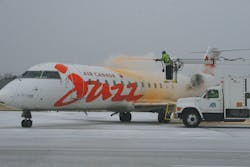For many airports, such as Port Columbus International Airport, Lambert-St. Louis International Airport and Indianapolis International Airport, being green is more than lip-service; it’s a way of life. Officials at these airports have committed themselves to greening their operations as a means of assuming greater environmental responsibility. And they have succeeded. Learn how Port Columbus’ green and clean propane autogas fleet is clearing the air, while Lambert St. Louis’ use of bio-friendly deicing fluid keeps contaminants from the ground water, and Indianapolis’ new parking lighting retrofit lands big savings.
Of the three examples, consider this: Port Columbus projects converted 19 of its 25 passenger shuttles to propane autogas and saved $5,000 in fuel in 2013 plus reduced emissions; Lambert-St. Louis significantly reduced greenhouse gas emissions through bio-friendly deicing; and the Indianapolis’ lighting retrofit saves more than $250,000 in energy and maintenance costs annually.
“Not only do sustainable practices help maintain the cost structure critical to an airport’s ability to attract and maintain competitive air service, they make airports better neighbors by reducing energy use and lowering air emissions,” says Mike Medvescek, chief operating officer for the Indianapolis Airport Authority.
AIR
Project: Convert passenger shuttles to propane-autogas
Where: Port Columbus International Airport
Cost: $8,000-10,000 per vehicle
Environmental Savings: In 2013, Port Columbus saved $5,000 on fuel in 2013, reduced greenhouse gas emissions generated by these vehicles up to 25 percent and slashed smog-producing hydrocarbon emissions by 40 percent.
Port Columbus International Airport operates 25 passenger shuttles that provide transportation between its long-term parking lots and entrances for arrivals and departures. These shuttles travel 50,000 miles and carry more than 2 million passengers every year.
When the State of Ohio enacted more stringent emissions standards in 2008, Port Columbus got busy researching alternative fuels before the standards took effect in 2010. Thomas Swackhamer, Port Columbus manager of parking, ground transportation and revenue, began exploring electric, ultra-low sulfur diesel (ULSD), natural gas, and propane autogas-fueled models to replace the airport’s fleet of diesel-fueled passenger shuttles.
Though Port Columbus tested an electric and a ULSD bus, they found those vehicles presented challenges that made them a poor fit for its use.
The airport then tested a propane autogas shuttle, a Ford F-450 cutaway converted by Starcraft. Port Columbus liked the performance, and placed an order for four more the following year using a Department of Energy grant. Currently, the airport operates 19 Ford F-450 cutaways, which have been converted with ICOM equipment by their supplier. By the end of this month, all 25 shuttles will operate on propane autogas.
“The primary reason we chose the fuel was its clean, green aspect … it fit really well into our existing sustainability plan,” says Swackhamer. Propane autogas reduces greenhouse gas emissions by up to 25 percent compared with gasoline and reduces smog-producing hydrocarbon emissions by 40 percent.
Propane autogas has proven to be a better fuel for both drivers and passengers when factoring in the time these buses spend idling. “The buses spend a lot of time waiting for passengers, especially at arrivals,” Swackhamer says. “We get complaints sometimes about the diesel buses’ exhaust when we’re waiting to pick people up. With propane autogas, customers comment that they’re glad we are using a green fuel instead of diesel.”
Propane autogas offers another benefit: less noise pollution.
“When you have four diesel buses running side by side waiting for passengers, diesel gets very noisy very quick,” Swackhamer says. “With propane you can barely hear them running.”
The airport currently pays less than $2 per gallon for propane autogas versus $3 to $4 per gallon for diesel. Their total fuel savings allowed the airport to recoup its upfront costs on all 19 conversions. After applying current fuel savings toward conversions, Swackhamer says the airport has saved $5,000 in 2013.
But surprisingly the biggest cost savings came in reduced maintenance. Compared with the diesel shuttles, the propane autogas shuttles have had much less downtime and have not experienced start-up problems in Columbus’ cold winter temperatures. “Oil changes alone cost less than half with propane autogas versus a diesel bus,” Swackhamer says.
The average conversion cost per vehicle was $8,000 to $10,000 — the same price the airport would pay to purchase a new diesel bus.
Swackhamer reports the airport recouped its return on investment with propane autogas shuttles within the first six months. “There aren’t that many airports running a 100-percent propane autogas-fueled fleet to my knowledge,” Swackhamer says. “When I get asked the question about how it’s performing and our experience, I tell them we’re satisfied with propane autogas and we don’t regret our decision at all.”
SEA
Project: Bio-friendly Deicing
Where: Lambert-St. Louis International Airport
Environmental Savings: If it consumes 1 million liters of Kilfrost DFsustain, the airport will see up to a 6,500 ton reduction in carbon emissions, equivalent to the emissions of 1,354 vehicles.
At Lambert-St. Louis International Airport sustainability is a way of life, and one with a long history that goes back to the late 1980s when the airport began using alternative fuels. So when the opportunity to incorporate bio-friendly deicing arose, it just made sense to go there—even if it meant being the first to do it in the United States.
“It’s more environmentally friendly, has lower BOD (biochemical oxygen demand) loadings, and since we’re regulated by our storm water permit, anything that could potentially reduce pollution makes sense,” says Jeff Lea, Lambert-St. Louis spokesperson.
Airport Terminal Services (ATS) began using Kilfrost DF Sustain Type 1 bio-propanediol for deicing operations a year ago. ATS serves several major airlines at Lambert, deicing approximately 30 percent of the airport’s commercial air traffic.
Kilfrost DFsustain is a bio-derived, fully sustainable aviation deicing fluid that was developed in partnership with DuPont, Tate and Lyle. It is qualified to AMS 1424 and ISO 11075 standards. The fluid is manufactured from corn-sugar-derived glycol (rather than oil), which is not only sustainable but completely recyclable.
ATS also worked with the airport to install a Type 1 Glycol Blending System, manufactured by Liquid Automation Systems, at the end of Lambert’s C concourse. This system allows ATS crews to customize the deicing mix to current weather conditions. Lambert is the first U.S. airport to use this system; ATS has it installed at three Canadian airports.
The system consists of a blending machine that takes glycol and combines it with a water feed. The mix is determined by historic outside air temperatures and current weather forecasts.
“We look at the weather forecast for an extended period of time, no more than 72 hours out, and if we know it’s going to be 26 degrees Fahrenheit, we will say based on regulatory requirements we need to subtract 18 degrees then build in a few extra degrees as a buffer,” says Peter Hansen, director of Deicing Sales & Operations for ATS.
Mixing deicing fluid on site provides both a cost benefit and an environmental savings, says Hansen. “If an airport buys premixed fluid, the price per gallon is higher because you’re shipping premixed fluid to the site. There’s also a savings if you mix it according to specific weather conditions.”
He explains pre-mixed fluids come in concentrations, typically 63 percent glycol and 37 percent water. But weather permitting, an airport may be able to go as low as a 45 percent glycol, 55 percent water solution. “There is an immediate cost savings there,” he adds. “It depends on your average dilution, but you could see a cost savings of up to 40 percent.”
Using sustainable glycol in this process also impacts the environment in a positive way, adds Gary Lydiate, chief executive at Kilfrost. Though Lambert-St. Louis is still calculating its savings after the completion of its first full year with the bio-friendly deicing system, Kilfrost estimates that if an airport consumes 1 million liters of DFsustain, it will see a carbon reduction of around 6,500 tons.
“From the airport’s point of view, it’s just good business whenever an airline and an airport can get together and try to improve any process,” says Lea. “Sustainability is about teamwork.”
LAND
Project: Lighting Retrofit
Where: Indianapolis International Airport Parking Garage
Environmental Savings: Reduced parking garage energy use by 50 percent on average and up to 65 percent during times of peak use.
Indianapolis International Airport’s 2.5-million square-foot parking garage completed an energy facelift in 2011. The project took advantage of newly developed green lighting technologies that were not yet mainstream enough to make it into the original construction of this LEED-certified campus. At the end of the project, the Indianapolis Airport Authority (IAA) had completely retrofitted its existing high-intensity discharge (HID) metal halide fixtures with induction lamps.
After working with ECO Parking Lights of Fishers, Ind., to set up a long-term demonstration of the firm’s domestic induction technology solution, airport officials determined it was time to move forward with the relighting project. ECO’s solution, which includes Osram Sylvania 100-watt Icetron induction lamps and ballasts, consumed half the energy of the existing metal halide lamps and ballasts, which consumed 208 watts of energy per fixture.
IAA hired Walker Parking Consultants of Indianapolis to compile bid documents and performance standards that were to be met in the change outs. The airport did not restrict the technology they would consider but advertised for a turnkey solution. The opportunity attracted bids for LED, fluorescent and induction lighting technologies. After testing various lighting systems, however, the airport ultimately decided on induction lighting.
The airport also updated the lighting in the Indianapolis Maintenance Center (IMC). The two projects combined, anchored by the garage project, accounts for an annual savings of more than $250,000 in energy and maintenance costs due to reduced energy consumption and the longer life of the lamps. The energy savings reduced CO2 emissions by 5,233 metric tons, the equivalent of taking 1,000 cars off the road annually.
Rather than replacing the fixtures, the solution included engineering a thermally designed retrofit kit to apply to the original fixtures. This option reduced landfill waste, while maintaining the look architects had originally envisioned. It also came with a new five-year parts and labor warranty fully backed by Osram Sylvania.
“Improving our efficiency through reduced energy consumption directly supports our mission of maintaining a viable airport system that supports and improves the quality of life in our region,” says Mike Medvescek, IAA chief operating officer.
The project also included installing individual photocells on perimeter fixtures, which are designed to turn lights off during daytime operation, additionally increasing energy savings.
In the two years since this installation, the domestic induction lamps by Sylvania have improved in both lumen output as well as lumen maintenance. Also, ECO Parking Lights developed the first and only fixture of its kind to accommodate multiple lighting technologies. The ECO FlexTech fixture, which recently won the 2013 Indiana Innovation Award for its technology agnostic design and non-glare LED solution, will accommodate induction, LED or Remote Phosphor LED lighting technologies.
“It is imperative for an owner to select a product that grows with them,” says William Longardner, director of product development, ECO. He adds ECO’s products can be updated over time to ensure maximum performance and efficiency


